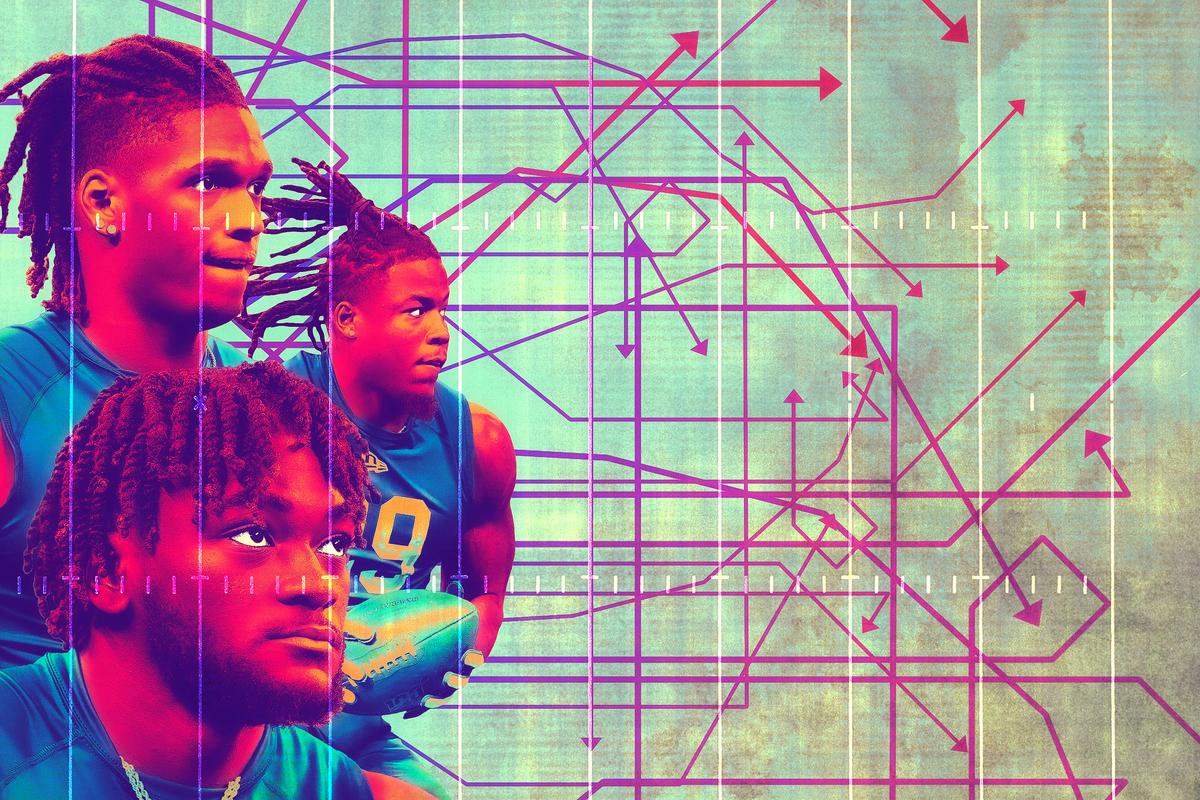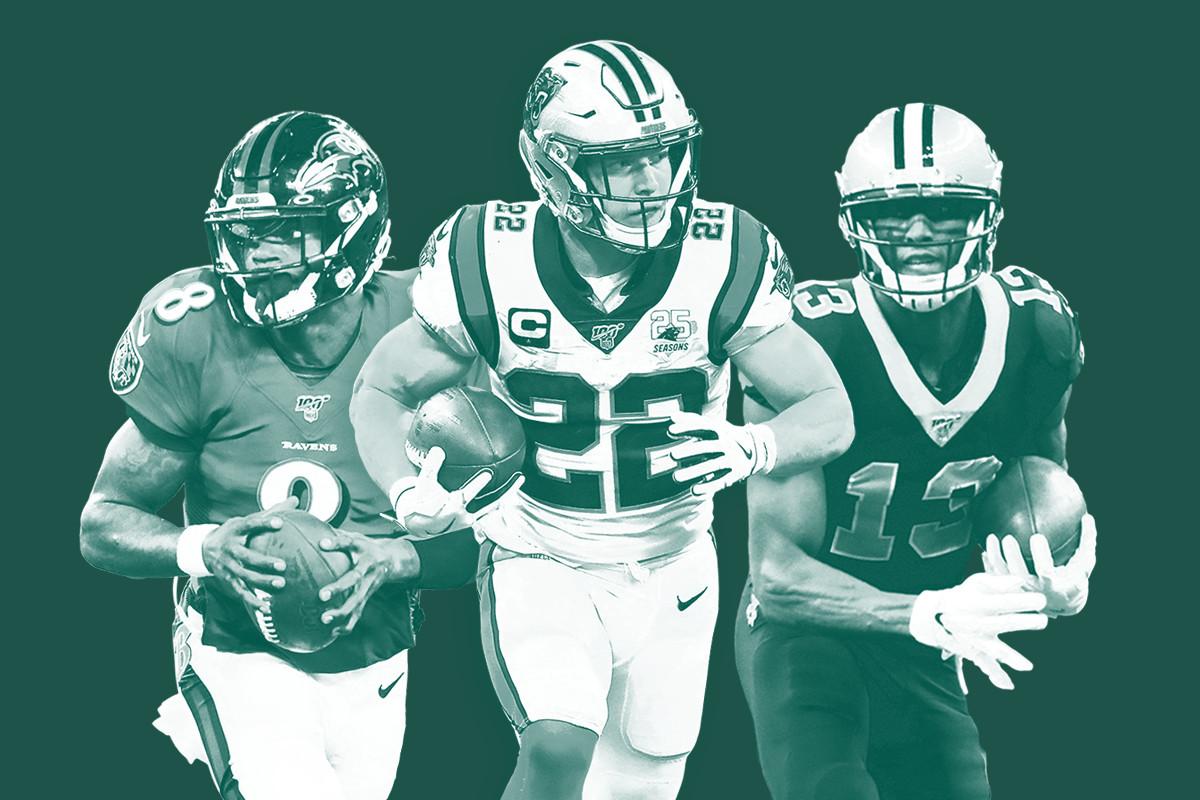
Michael Pittman Jr. met Philip Rivers this summer when the new Colts quarterback got some of his future pass catchers together for a three-day workout in Indianapolis to make up for lost minicamps and OTA sessions. The group repped routes on air and started to install portions of the offense. It’s a new playbook for Rivers, who signed a one-year deal with Indianapolis in free agency this offseason after 16 years with the Chargers, just like it is for Pittman. But the information gap between the rookie wide receiver and the 38-year-old quarterback was large enough that Pittman couldn’t quite process Rivers as a fellow player.
“I called him ‘Coach,’” Pittman told me. “As soon as I said it, he paused for a second, and I went ‘Oh, sorry.’ It was just awkward.”
There are a kaleidoscope’s worth of ways to look at the 2020 rookie class of wide receivers. A record 13 of them were drafted in the first and second rounds this year, and their teams are hoping they’ll be productive in the NFL relatively quickly. Wide receivers have a steep learning curve in the first year, which makes those hopes potentially unrealistic. With less practice time than usual because of the COVID-19 pandemic, players will be asked to go from awkward greetings to crisp connections with quarterbacks as quickly as possible. There is hope: All of this is happening a year after the 2019 rookie receivers class was the most productive group of first years since Odell Beckham Jr., Mike Evans, and Kelvin Benjamin each had more than 1,000 receiving yards in 2014, and last year’s rookies may show a path forward for this year’s group to speed up the process.
There have been only 11 rookie wide receivers in the last 20 years to have at least 1,000 receiving yards in their first seasons. While the job of a receiver can look like “line up and go” at times, it’s proved to be one of the harder positions to adjust to from college to the NFL. A Pro Football Focus study found that receivers usually hit their stride after their second season, but that the jump in overall productivity and efficiency from the first year to the second is significant.
“Receivers in college football, by and large, not 100 percent, have it really easy in college football with the defenses they see and the offensive schemes they’re in and what they’re going against. I see too many wide receivers when you’re watching college tape running wide open and not running NFL-type routes on a consistent basis,” said Broncos coach Vic Fangio, whose team drafted two receivers—first-rounder Jerry Jeudy, and second-rounder KJ Hamler—with their first two picks in this year’s draft.
As Fangio alluded to, the lack of quality press coverage receivers face in college is one reason for NFL coaches to temper their short-term expectations for first-year receivers. Another reason is the increased complexity of NFL offenses. At the combine this year, Raiders general manager Mike Mayock described watching film and seeing individual coaches at the college level motioning to receivers on the field, telling them which routes to run.
Broncos receiver Courtland Sutton, who had a good rookie year in 2018 before following the second-season breakout model with 1,112 receiving yards last year, said he’s been telling Jeudy and Hamler to keep things as simple as possible this year and not get overwhelmed.
“I put so much pressure on myself because I never wanted to disappoint Demaryius [Thomas] or Emmanuel [Sanders]. I put so much pressure on myself. I had fun, but there were times where I was so in my own head about not making a mistake,” Sutton said.
Sutton’s experience should make him a good source of information for Jeudy and Hamler as they acclimate to the NFL. Looking at the receivers drafted the year after he entered the NFL, though, may offer more immediate clues.
A high number of last year’s rookie receivers contributed quickly. There have been eight rookies in the past 10 years to have run at least 250 routes and earn a PFF receiving grade of 80.0 or higher and two of them, Terry McLaurin in Washington and A.J. Brown in Tennessee, were rookies last year. There were plenty of others who were productive. Notably, their contributions did not follow the pattern of their draft order.
Marquise Brown and N’Keal Harry were the only two receivers taken in the first round of the 2019 draft, and they went to the Ravens and the Patriots, respectively. Brown was part of a great Ravens offense and had 46 catches for 584 yards and seven touchdowns in 14 games while Harry began the season injured and finished with just 12 catches for 105 yards in seven games. Brown was by far the more successful of the two, but neither was the most productive rookie in the class.
A.J. Brown, who had 52 catches for 1,051 yards and eight touchdowns last season, went in the second round. So did San Francisco’s Deebo Samuel (57 passes, 802 yards, and three touchdowns) and Seattle’s DK Metcalf (58 receptions, 900 yards, and seven TDs). In the third round, McLaurin and Pittsburgh’s Diontae Johnson wound up looking like great picks.
The draft is fluky enough that this isn’t shocking. It’s worth noting, though, that some of the imperfections that caused those players to be drafted outside of the first round also seemed to require their coaches to think carefully and smartly about how to use them.
Metcalf might have gone higher if he hadn’t been scrutinized for a perceived lack of agility; once he was in the NFL, the Seahawks simply focused on using his physicality and burst, which is explosive for a player of his size. Mecole Hardman might have gone higher in the draft if he had a bigger frame, but Kansas City could teach a college seminar on how to create space in ways that took advantage of his speed.
“There’s always a good coach behind a lot of those players and understanding that we don’t know it all,” Sutton said.
Those rookies that succeeded last year had defined roles that limited the menu of options they needed to grasp and took advantage of their strengths. That’s not always the easiest way for coaches to think about players they draft particularly high—they’re not supposed to be role players, they’re supposed to be every-down, go-to guys. In this shortened year, though, teams may wind up using their top draft picks in more specialized roles as they try to simplify things.
That will vary across the 13 receivers who went in the first two rounds this year (compared to 12 in 2014 with Beckham, Evans, Jarvis Landry, and Davante Adams) since some will feel more pressure than others. Players like Jalen Reagor, drafted no. 21 overall by the Eagles, and Justin Jefferson, the Vikings’ pick at no. 22, are joining teams expected to make the playoffs that have offenses in need of receiving talent. Others, like Jeudy or Dallas’s CeeDee Lamb, don’t need to be counted on right away, but still come in with big expectations.
A player like Brandon Aiyuk, taken in the first round by the 49ers, may be in the best position. Kyle Shanahan’s well-documented desire to draft him stemmed from a specific role he felt Aiyuk could play in San Francisco’s yards-after-catch-creating offense. The Colts are hoping Rivers can be revitalized behind their good offensive line and that Pittman’s size and physicality will be an asset.
Pittman was optimistic about his grasp of the offense after studying it on Zoom during the offseason and meeting up with Rivers for three days. Still, walking into the facility for the first time in late July, it was obvious to him that he was in a different spot from the veterans, especially Rivers. There were challenging points during the virtual offseason, like when a video feed would stall or cut out, and Pittman would think a coaching point applied to one slide when really, it was meant for another.
For now, he’s been running plays over and over in his mind and memorizing what he can about Rivers’s preferences from his receivers.
“On an in route, he likes it a little faster because he’s going to get the ball out early. Just be ready to get your eyes back fast and be ready to catch a ball,” Pittman told me.
It is simply a lot to ask when, normally, at this point, they’d have repped every in-breaking route concept in the playbook. The Colts didn’t draft Pittman just for this season, so a slow start isn’t the end of the world and may be a fact of NFL life in 2020. Frank Reich and the rest of the offensive staff in Indianapolis will try to keep things manageable. What worked last season shows that doesn’t just mean ripping out pages from the playbook, but defining a player’s precise role.


